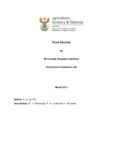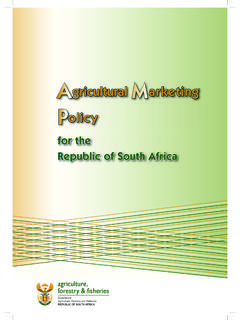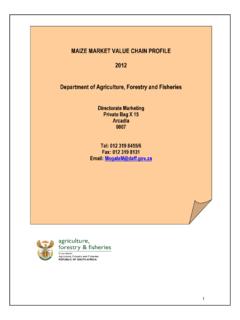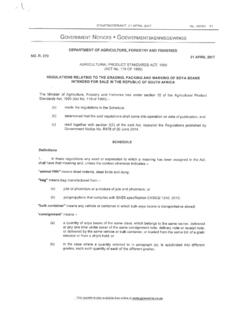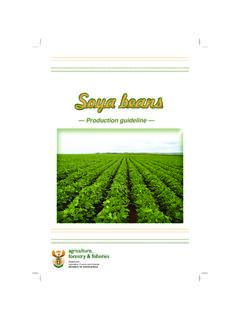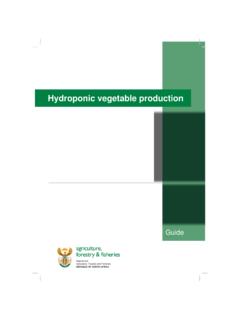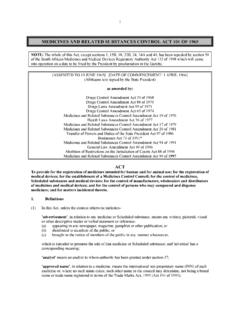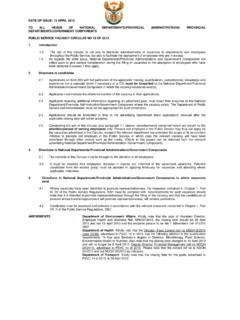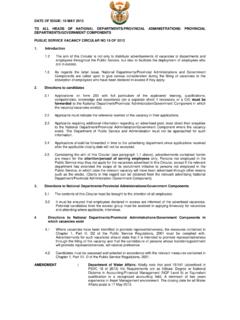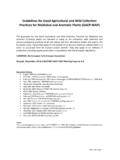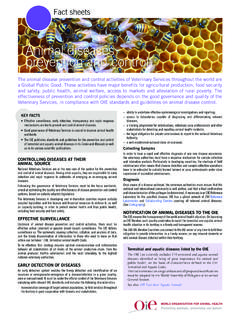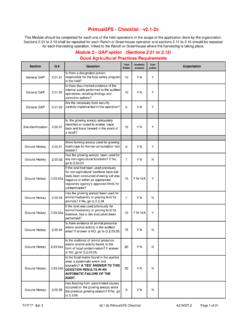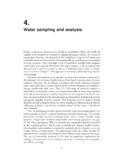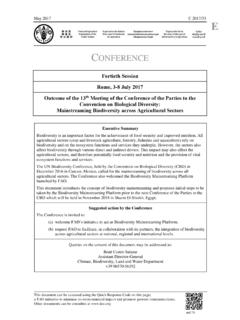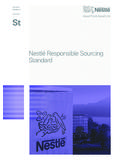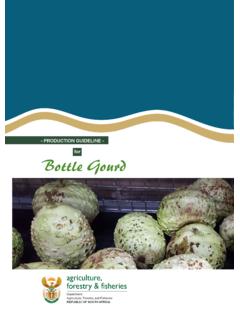Transcription of Lavender production - Department of Agriculture, …
1 ESSENTIAL OIL CROPSP roduction guidelines for lavenderLavender productionagriculture,forestry & fisheriesDepartment: Agriculture, Forestry and FisheriesREPUBLIC OF SOUTH AFRICAN ovember 2009 Department of agriculture, forestry anD fisheries Directorate: plant productionLavender production2009compiled by Directorate plant production in collaboration with members of saeopa and KarWil consultancy obtainable from resource centre Directorate agricultural information services private Bag X144, pretoria, 0001 south africa the web: by Directorate agricultural information services Department of agriculture, forestry and fisheries private Bag X144, pretoria, 0001 south africafurther information or contacts Directorate plant production , Division industrial crops tel: 012 319 6079 fax: 012 319 6372 e-mail: I: General aspects.
2 1 1. classification .. 1 2. origin and distribution .. 2 3. production levels .. 2 4. major production areas in south africa .. 3 5. Description of the plant .. 4 6. cultivars .. 5 7. climatic requirements .. 7 8. soil requirements .. 8 Part II: Cultivation practices .. 8 1. propagation .. 8 2. soil preparation .. 9 3. planting .. 10 4. fertilisation .. 11 5. irrigation .. 12 6. Weed control .. 12 7. pest control .. 13 8. Disease control .. 13 9. other cultivation practices.
3 13 10. harvesting .. 14ivPart III: Post-harvest handling .. 15 1. sorting and distillation .. 15 2. grading .. 16 3. packaging and storage .. 17 4. marketing .. 17 Part IV: production schedules .. 17 Part V: Utilisation .. 19 1. industrial .. 19 2. cosmetic .. 19 3. pharmaceutical and therapeutic .. 19 4. food and flavouring .. 20 5. other .. 20 6. safety data .. 20 References .. 201 Part I: General aspects1. CLASSIfICATION Scientific name: Lavandula angustifoliaCommon names: (L. angustifolia) true Lavender , english Lavender ; (L.)
4 Dentata) french Lavender ; (L. latifolia) spike Lavender ; (L. stoechas) french or spanish Lavender ; hybrids of L. angustifolia x L. latifolia are referred to as lavandinfamily: lamiaceae(Photo: Alberts)22. ORIGIN ANd dISTRIbUTION most Lavender originates in the mediterranean basin, in rocky, calcareous areas. Lavender occurs over north africa, the mediterranean, europe and West-ern india. Lavender was cultivated by the ancient greeks and romans, and in elizabethan england. the name Lavender comes from the latin verb lavare to wash or to bathe.
5 Spike Lavender grows wild over a large part of the mediter-ranean area, preferring warmer and lower regions than Lavender and production LEVELSS outh Africatrue Lavender yields 8 to 30 kg and lavandin 40 to 220 kg essential oil per hec-tare (ha), and 500 to 1 000 kg dried flower stems per hectare, depending on location, management and cultivar. small producers should aim at high quality, value-added markets for essential oil and flower production . Lavandula angustifolia in france(Photo: Provided by members of SAEOPA and KARWIL Consultancy)3 Internationallythe world production of high-quality Lavender oil is 200 metric tons per year.
6 The ratio of Lavender to lavandin production worldwide is 1:5. the price of lavandin is lower than for Lavender oil. lavandin plants produce more oil and are hardier than Lavender plants. the world production of lavandin oil is 1 000 metric tons per major producing areas of Lavender oil are in Bulgaria, england, france, ussr, yugoslavia, australia, usa, canada, south africa, tanzania, italy and spain. true Lavender for perfume is mainly cultivated in europe, especially is mostly cultivated in spain, france, italy, the Balkan peninsula, aus-tralia and tasmania.
7 In recent years Bulgaria has become a major producer. spike Lavender has its main production areas in spain but grows wild over a large part of the mediterranean area, preferring warmer and lower regions than Lavender and lavandin. Worldwide production of spike Lavender oil is 150 to 200 tons per MAjOR production AREAS IN SOUTh AfRICA Lavender is cultivated in the Western and eastern cape, KwaZulu-natal, free state, gauteng, limpopo and mpumalanga provinces. the weather conditions in the Western cape are very similar to the mediterranean in the KZN Midlands and Limpopo Province (Photos: Alberts)45.
8 DESCRIPTION Of ThE PLANTS temlavender is a perennial, bushy shrub growing 0,3 to 1,2 m high. true Lavender has a compact and rounded growth form. Leavesthe aromatic evergreen leaves are completely opposite and up to 5 cm long. flowersflowering occurs in summer. the flowers form interrupted spikes and have a very sweet fragrance. Essential partthe plant parts used for oil distillation are the flowers and, in smaller quantities, leaves. essential oil from only the flowering tops is of higher quality than oil (Photo: Alberts)5obtained from the leaves.
9 For dried flower production the flowers with stems are cut CULTIVARS there are 48 species of Lavender with hundreds of various genotypes differentiated by variations ranging from growth form to chemical composition of essential oil. there are three main species within the genus producing Lavender essential oil. 6L. angustifolia (true Lavender , english) 6L. latifolia (spika, broad leaves) 6L. angustifolia x L. latifolia (lavandin)the following six sections exist, each with hybrids and subspecies: lavandula, Dentata, stoechas, pterostoechas, chaetostachys, following are mostly farmed with on a commercial scale for essential oils: 6true Lavender oil, which is derived from Lavandula angustifolia (synonym L.)
10 Officinalis, L. vera, L. spica)Lavandula angustifolia (true Lavender , English)(Photos: Provided by members of SAEOPA and KARWIL Consultancy)6 6french Lavender oil from L. dentata 6spike Lavender oil, which is derived from L. latifolia (syn. L. spica). 6spanish Lavender oil from L. stoechas. 6lavandin oil is derived from L. angustifolia x L. latifolia hybridsthese Lavender essential oils are each unique in composition and used in dif-ferent applications. under these main species there are several cultivars that are being planted for com-mercial production of es-sential choosing a laven-der cultivar for essential oil production , the fol-lowing information has to be considered:Lavandin cultivars from left to right: Grappenhall, Provence, Grosso, dutch Mill, Abriali and SealTrue Lavender from left to right: Vera, Munstead, hidcote and jean davisL.
